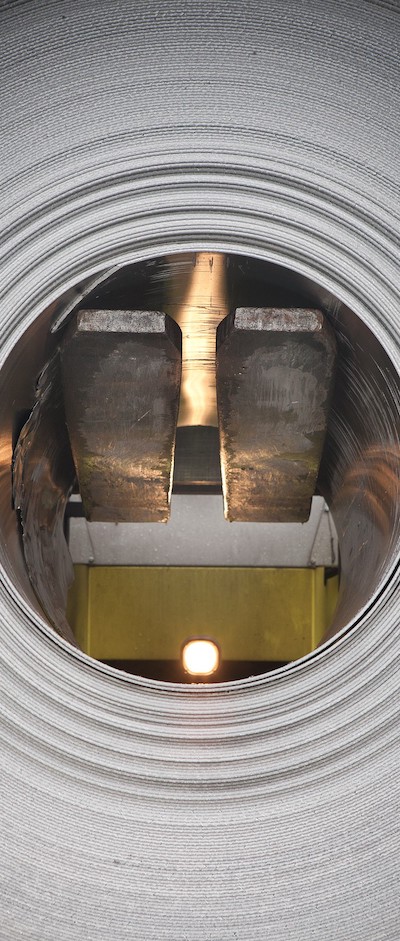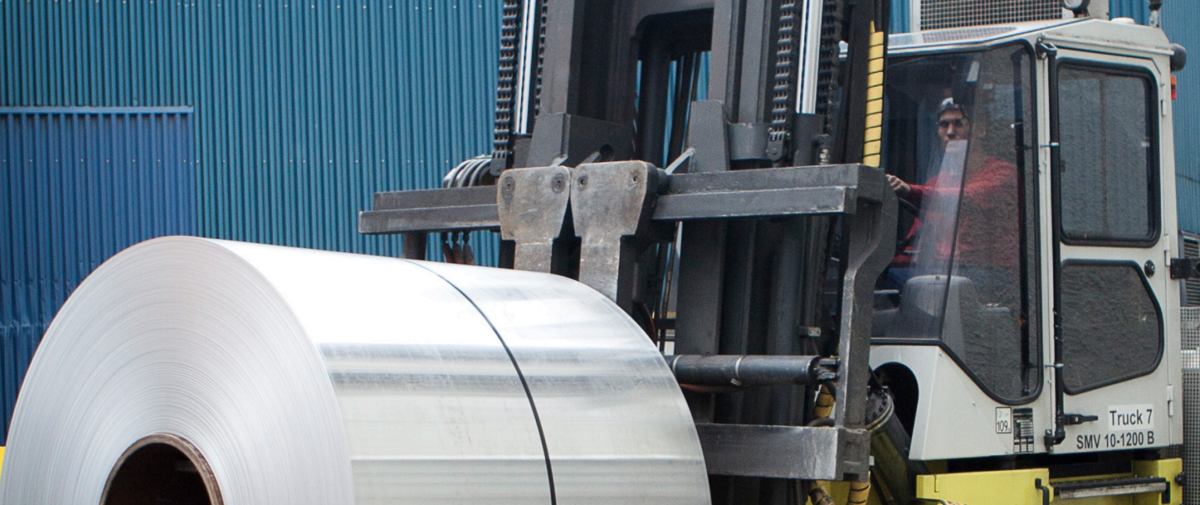With over 400 years of metalworking experience and history, Sapa Heat Transfer AB faces unique challenges. Twelve customized forklifts from Konecranes seamlessly connect the company’s past, present and future for more efficient production and improved safety.
Founded in 1580, the Sapa Heat Transfer factory in idyllic Finspång, Sweden has a long history in metalworking. Cannons produced at the site were used as far afield as the American Revolutionary War. So it’s safe to say they know what they’re doing at this sprawling, 120,000 square meter production site, which today specializes in the production of aluminum strips for heat exchangers, mainly for the automotive industry. In fact, the company holds an impressive 14% of the global market in this segment and has its sights set on even more.
 In recent years, Sapa Heat Transfer has made strategic investments to ensure the highest levels of safety, improve quality, and make production more efficient. Of course, integrating cutting-edge technology and a centuries-old production facility presents a number of special challenges, not least when it comes to lift trucks. At first Sapa tested electric forklifts, but they proved unable to handle the pace of production. They needed a better solution fast. “Konecranes was the clear choice. No other company could meet all of our specific needs,” asserts Rolf Andersen, Truck Coordinator, who’s been making sure that the company’s lift trucks are safe and working well since 2009.
In recent years, Sapa Heat Transfer has made strategic investments to ensure the highest levels of safety, improve quality, and make production more efficient. Of course, integrating cutting-edge technology and a centuries-old production facility presents a number of special challenges, not least when it comes to lift trucks. At first Sapa tested electric forklifts, but they proved unable to handle the pace of production. They needed a better solution fast. “Konecranes was the clear choice. No other company could meet all of our specific needs,” asserts Rolf Andersen, Truck Coordinator, who’s been making sure that the company’s lift trucks are safe and working well since 2009.
Sapa had many requirements but three were “must-have”: excellent maneuverability combined with high lifting stability, reliability in constant use, and safety/ergonomics. The twelve 10-ton Konecranes forklifts busily crisscrossing the facility today prove that Sapa found its answer.
“Our aluminum casting, rolling, and finishing are carried out across a large production infrastructure that’s been here for hundreds of years,” explains Andersen. “To maneuver around buildings through narrow roads, we need trucks with a much shorter wheelbase than normal.”
With their tailor-made 2,800 mm wheelbase, Sapa’s Konecranes SMV 10-1200 B forklift fit easily wherever they need to go. Thanks to a 5-ton counterweight added to the back of the sturdy, box-type chassis, these trucks can handle their daily loads with ease. “Other trucks practically threw me on my nose sometimes. That never happens with our trucks now,” says Andersen. “I mean, how many people put a 16-ton upright mast on a 10-ton truck? Yet it’s still more stable and secure, by far, than any other truck we’ve had.” Driver Viktor Kjellander agrees: “Even with a shorter wheelbase, these are stronger and more stable than other trucks. I feel completely secure lifting anything I need to lift.”
The powerful, low-emission Volvo TAD 660 VE engines provide the much-needed reliability for Sapa’s demanding production schedules. “We run practically 24/7, and we drive at 98% max. capacity all the time. The trucks in our rolling mill log about 5,000 hours per year,” explains Andersen. “It’s extremely important for us that our trucks are rolling all the time,” confirms Anna Stenlund, Communication Manager for Sapa Heat Transfer.
It’s also important for Sapa that these tough trucks can handle the most delicate materials. Each aluminum coil can weigh anywhere from 8 to 12 tons. Meanwhile, some of the coiled aluminum strips are a mere 0.05 mm thick. They need to be handled very carefully in the midst of a fast-paced production environment. The coils are valuable. “I tell our drivers that damaging one of these coils is like damaging a brand new car,” shares Stenlund. The auto tilt-to-zero feature in the lift mast minimizes costly damage to the material during offloading. According to Andersen, it does a better job than a driver can do manually and it’s more secure.
The forks themselves are also specially designed, with tapering starting 500 mm from the tip to allow the trucks to carry standard pallets for other daily tasks such as transporting scraps – adding valuable flexibility.
When deciding what truck brand and model to purchase, Sapa assembled an extensive internal work group that determined the truck requirements. This work group included members of the company’s industrial health service team. “We work with a safety-first philosophy. Ergonomics are key, not only for everyone’s wellbeing, but also for boosting productivity,” says Andersen. The finished requirement list was lengthy, detailed and unique. For example, at the rolling mill, the aluminum is heated to 500 degrees Celsius during hot rolling. When the driver picks up a load, it can be as hot as 350 degrees. This consideration, combined with the requirement of constant operation, led to the addition of strategic ventilation in the cabs, fire-proof hoses, and a semi-automatic fire extinguishing system that uses a water-based formula to smother fire inside the cab.
Konecranes built a long list of special features into the SMV 10-1200 B forklift for Sapa, including personalized USB keys for each driver to log all driving statistics, integrated alcohol breath analyzers, an auto function which prevents use of the computer while in gear, rotating RoTo driver seats for added visibility, extra brake lights at eye level, reverse distance control, adjustable driver speed limits, and additional steps for a more natural climb into the cab. Even the specially ordered yellow body color is designed to increase safety.
When asked what the greatest advantage is in selecting Konecranes forklifts , Andersen doesn’t hesitate: “It’s in getting quality trucks customized to our each and every need.”

 In recent years, Sapa Heat Transfer has made strategic investments to ensure the highest levels of safety, improve quality, and make production more efficient. Of course, integrating cutting-edge technology and a centuries-old production facility presents a number of special challenges, not least when it comes to lift trucks. At first Sapa tested electric forklifts, but they proved unable to handle the pace of production. They needed a better solution fast. “Konecranes was the clear choice. No other company could meet all of our specific needs,” asserts Rolf Andersen, Truck Coordinator, who’s been making sure that the company’s lift trucks are safe and working well since 2009.
In recent years, Sapa Heat Transfer has made strategic investments to ensure the highest levels of safety, improve quality, and make production more efficient. Of course, integrating cutting-edge technology and a centuries-old production facility presents a number of special challenges, not least when it comes to lift trucks. At first Sapa tested electric forklifts, but they proved unable to handle the pace of production. They needed a better solution fast. “Konecranes was the clear choice. No other company could meet all of our specific needs,” asserts Rolf Andersen, Truck Coordinator, who’s been making sure that the company’s lift trucks are safe and working well since 2009.